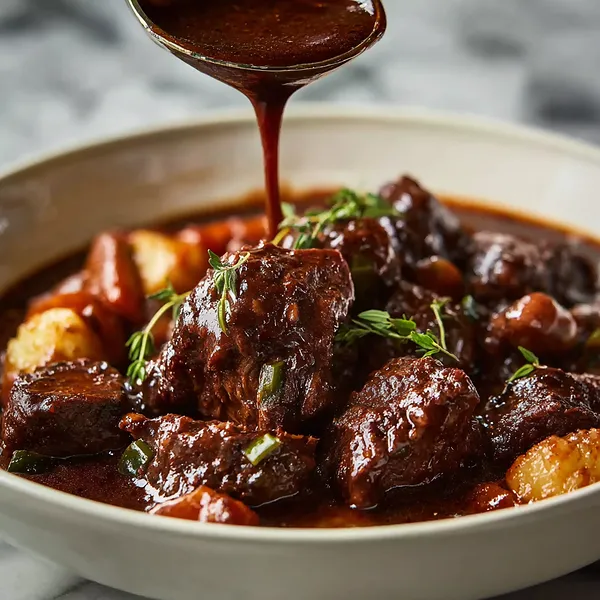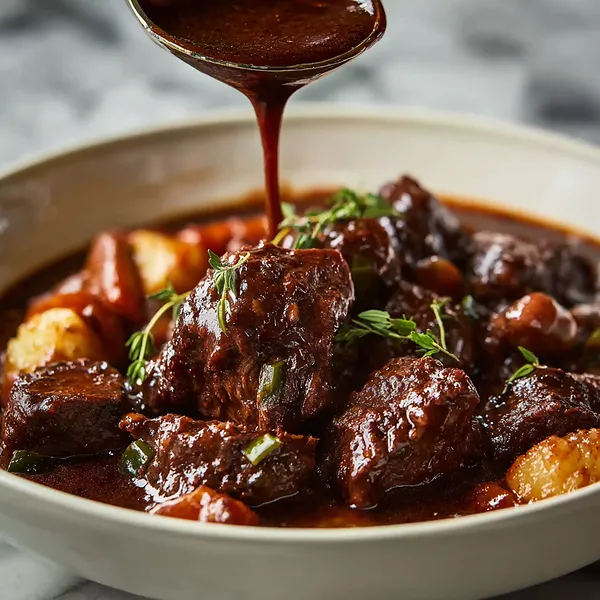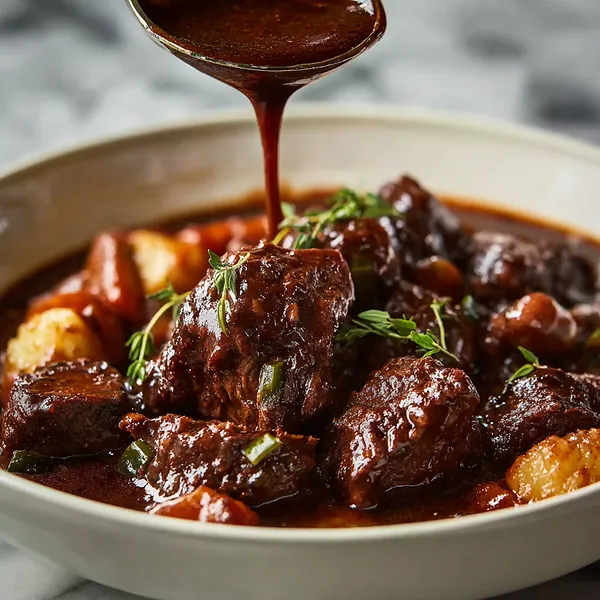 pin it
pin it
I first encountered true beef bourguignon at a tiny bistro in Lyon, where the chef explained that this dish was born from the need to transform tough cuts of meat into something sublime. What captivated me wasn't just the taste, but the entire process - the careful browning of the beef to develop flavor, the way the wine reduces and concentrates, how the vegetables add sweetness and texture. When I returned home, I was determined to recreate that magic. After several attempts and studying classic French techniques, I finally understood that bourguignon isn't just about following a recipe - it's about understanding how each step builds upon the last. The dish teaches patience; you can't rush the browning, you can't skip the wine reduction, and you certainly can't hurry the braising. Each element contributes to creating layers of flavor that make this more than just beef stew. It's a masterclass in how time and technique can elevate humble ingredients into something truly extraordinary.
Why I love this recipe
What I love most about beef bourguignon is how it embodies everything beautiful about cooking - it's both rustic and elegant, simple yet sophisticated. There's something deeply satisfying about the transformation that happens during those hours of slow cooking. You start with tough pieces of meat and basic vegetables, but through the alchemy of time, wine, and heat, everything becomes tender and harmonious. I love that this dish forces you to slow down and be present in the kitchen. You can't multitask your way through browning the beef or reducing the wine - it demands your attention and rewards it generously. The recipe also carries so much history and tradition; every time I make it, I feel connected to generations of French cooks who perfected this technique. But perhaps what I love most is how it brings people together. This isn't a weeknight dinner - it's an event, a reason to gather friends around the table and savor not just the food, but the entire experience of sharing something special.
What You Need From Your Kitchen
- Beef chuck roast: cut into large cubes and pat completely dry before browning
- Red Burgundy wine: use a bottle you'd drink, reserve some for serving
- Pearl onions: blanch briefly in boiling water to make peeling easier
- Mixed mushrooms: quarter larger ones, leave small ones whole for best texture
- Thick-cut bacon: dice and render slowly to extract maximum fat for browning
- Fresh thyme: use whole sprigs, remove stems before serving
Let's Make These Together
- Master the browning technique
- The key to incredible flavor is properly browning the beef. Pat each piece completely dry, season well, and don't overcrowd the pot. Let each piece develop a deep, golden crust before turning. This creates the foundation for the entire dish's flavor profile.
- Reduce the wine properly
- When you add the wine, let it bubble and reduce by half. This concentrates the flavors and cooks off the harsh alcohol, leaving behind rich, complex wine essence that will permeate every bite of the finished dish.
- Time the vegetables perfectly
- Add the mushrooms only in the last 30 minutes to prevent them from becoming mushy. The pearl onions and carrots can go in from the beginning as they need the full braising time to become tender.
- Check for doneness properly
- The beef is ready when it shreds easily with a fork but still holds its shape. If it's falling apart completely, it's overcooked. The sauce should coat the back of a spoon but not be too thick.
 pin it
pin it
Switch Things Up
I'll never forget the first time I attempted this recipe - I was so intimidated by its reputation! I remember standing in the wine shop, debating whether to use an expensive bottle or something more budget-friendly. The butcher convinced me to go with chuck roast instead of more expensive cuts, and I'm so glad I listened. As the dish braised away for hours, my entire house filled with the most incredible aroma. When I finally tasted it, I couldn't believe I had created something so restaurant-quality in my own kitchen. The beef was so tender it fell apart with a fork, and that sauce - oh my goodness - it was like liquid gold. Now I make double batches because it's even better the next day, and I've learned that the secret is really in the browning and not rushing the process.
Perfect Pairings
This rich bourguignon pairs beautifully with creamy mashed potatoes, buttery egg noodles, or crusty French bread for sopping up that incredible sauce. For wine, serve with the same Burgundy you used for cooking, or try a Côtes du Rhône. The dish also works wonderfully with roasted root vegetables or a simple green salad with vinaigrette to cut through the richness.
 pin it
pin it
Frequently Asked Questions
- → What's the best cut of beef for bourguignon?
Chuck roast is ideal because it has enough marbling and connective tissue to become incredibly tender during the long braising process. Avoid lean cuts like sirloin, which will become tough and dry.
- → Can I make this without wine?
While wine is traditional and essential for authentic flavor, you can substitute with additional beef broth plus a tablespoon of red wine vinegar for acidity. However, the result will be quite different from classic bourguignon.
- → How do I prevent the sauce from being too thin?
If your sauce is thin, remove the lid during the last 30 minutes of cooking to allow evaporation. You can also simmer it uncovered on the stovetop after cooking to reduce it further.
- → Can I make this in a slow cooker?
Yes, but brown the beef and vegetables in a skillet first, then transfer everything to the slow cooker. Cook on low for 6-8 hours. The texture won't be quite the same as oven braising, but it's still delicious.
- → How long will leftovers keep?
Bourguignon keeps beautifully in the refrigerator for up to 4 days and actually improves in flavor. It also freezes well for up to 3 months. Reheat gently on the stovetop, adding a splash of broth if needed.
Conclusion
Beef bourguignon represents the pinnacle of French comfort cooking, transforming simple ingredients into something truly extraordinary through patience and technique. The slow braising process creates incredibly tender meat while the wine reduces into a rich, complex sauce that coats everything beautifully. This dish improves with time, making it perfect for entertaining or meal prep. It's a recipe that connects us to centuries of French culinary tradition while delivering pure satisfaction in every bite. Once you master this classic, you'll have a showstopper dish that never fails to impress.
